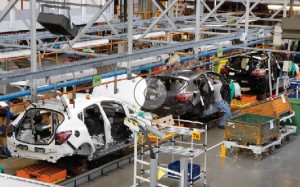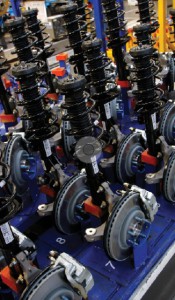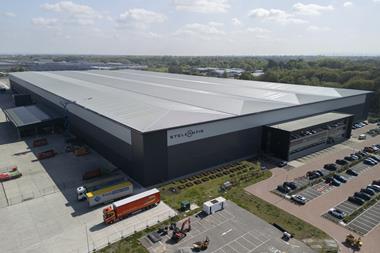Opel/Vauxhall has a made a breakthrough in managing its vehicle orders and forecasting in real time together with material availability and logistics, thanks in parts to systems implemented by software-provider flexis
In today’s complex supply chains, with a proliferation of customer options and global material, one major challenge for carmakers like Opel/Vauxhall is to manage parts availability against production schedules as far in advance as possible, and with as much flexibility up to final assembly. After all, any changes to supply that cannot be resolved might result in expensive premium freight; furthermore, a plant’s sudden need to swap the sequence of vehicle production because of shortages could delay customer deliveries.

To maintain stability, according to Michael Scholl, director of supply chain, Opel works with a material plan based on 11 months of fully specified forecast vehicle orders and projections. Orders can be changed at any time before the plant production sequence is fixed. “To protect the suppliers from volatility created by order changes, we work with a pick-up sheet concept that fixes material call-offs two weeks prior to pickup at the supplier side,” he says.
A difficulty in managing these orders is the separation among most manufacturers between those who manage orders, material supply and logistics. In cases where one team might see changes or disruptions – whether it’s an order change, a material shortage or delayed shipment – there is usually a time lag before others know and react.
However, Opel has recently made a step-change in its order processes. Last year, it implemented a suite of IT systems from software provider flexis – supported by an organisational realignment – which has helped the carmaker to integrate the workflow of the teams responsible for forecasts, orders, materials management and production scheduling.
From sequential to parallel planning
Read these other stories that form part of this exclusive coverage of Opel/Vauxhall's supply chain management:
In this new process, called ‘order slotting’, Opel takes real and forecast vehicle orders at the time of order entry and ‘explodes’ them into part numbers based on the bill of material. The resulting part requirements are then compared in real time with the availability and constraints of these part numbers. This approach – which is actually a combination of three, off-the-shelf flexis modules that manage demand, capacity and inventory – covers planning for tier one suppliers to Opel’s plants. The software solution brings together vehicle orders that start from 11 months and material information for eight months up until nearly three weeks before production, when the information is passed onto plants.

“The systems cover all of the forecast horizon as well as the customer order horizon,” says Reisch. “When a new [vehicle] order comes in, it is allocated to a plant and calculated against the availability of capacity and material availability using the due date information in the order.”
For Opel, these system processes have replaced the planning and scheduling functions in its own mainframe production planning system. The flexis software effectively synchronises programme, supply and order planning processes that carmakers usually manage sequentially, which tends to mean supply shortages or other building constraints are not immediately accounted for. Instead, manufacturers usually do a ‘batch run’ overnight or once a week to check for issues. Build schedules and material orders would then be adjusted manually.
By contrast, ‘parallel planning’ couples programme scheduling and material availability. The system runs a simulated bill of material ‘explosion’ to verify part availability of vehicle orders, as well as an ‘implosion’ (which checks the incoming parts against the schedule vehicle production) to gain an immediate picture of the supply chain.
This bridge between those responsible for orders and material is a breakthrough in Opel/Vauxhall’s supply chain management. “By implementing this system we have broken up existing organisational boundaries,” says Scholl. “People from order management, material management and from logistics are looking at the same data which leads to quick, cross-functional decisions.
“It’s a paradigm shift towards automation and real-time data transparency which definitely reduces premium freight and bottlenecks, but even more importantly it allows us to keep delivery date promises towards our customers as we do not move around orders anymore due to material shortages,” Scholl adds.
Oliver Reisch says the global nature of the supply chain, as well as its continual flux, makes incorporating material constraints more important in production planning. “The further out in time you go, the fewer customer orders and the more forecasts orders there are, which could change over time,” he says. “Your production is constrained based on the supply chain decisions you have made long term, so you must consider availability or capacity constraints both in the factory and the supply chain.”
Testing limits
Bringing together this information isn’t the only reason Opel opted for this solution. Also critical, says Reisch, is the systems’ “service orientation”. Whereas the

Along with the bill of material explosion and implosion, an Opel user can highlight a specific part and check manually against ASNs to measure risks or assess potential fixes. For example, if a part is showing a constraint, a user can click on it and run a scenario based on expediting the shipments, or a realignment of orders. “The system can automatically check these updates and helps you see how far you get with an accelerated material flow,” says Reisch.
The sheer number of parts involved means order slotting is currently set to high levels of monitoring for long-lead time parts and critical components, says Scholl, but there is no limit to how many parts the solution can incorporate. Opel is already integrating the software into production scheduling at powertrain plants that include parts down to the last day and week.
Further out, flexis is looking into how its product portfolio could be further integrated with OEMs’ manufacturing execution systems to cover more production processes. It is also looking further upstream, such as aligning demand and capacity planning with dealers, as well as considering vehicle logistics as a constraint in the order process.
“We see potential for such systems to be integrated into more business processes, connecting all the dots across the supply chain with real-time updates,” says Reisch.
At Opel, meanwhile, Scholl believes that the diversification of models offered to customers will require further integration of the processes between production planning and dealer deliveries. “Model fragmentation will drive more volatility into the system and will further sharpen the need for a cross-functional balancing between flexibility for sales on the one hand and stable schedules on the other,” he says.












































